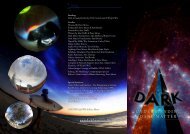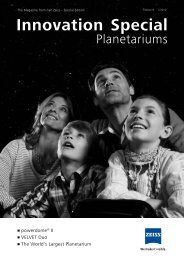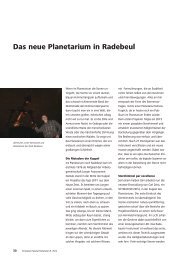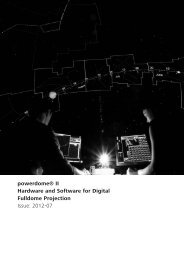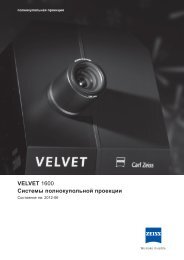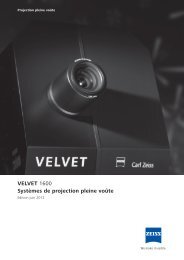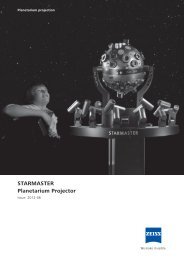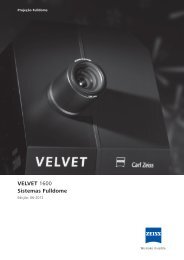VELVET 1600 brochure - Carl Zeiss Planetariums
VELVET 1600 brochure - Carl Zeiss Planetariums
VELVET 1600 brochure - Carl Zeiss Planetariums
Create successful ePaper yourself
Turn your PDF publications into a flip-book with our unique Google optimized e-Paper software.
Fulldome Projection<br />
<strong>VELVET</strong> <strong>1600</strong><br />
Fulldome Systems<br />
Issue: 2012-06
The Ultimate Black for Brilliant Projections.<br />
<strong>VELVET</strong> projector in the mounting frame<br />
2<br />
The perfect projection system for<br />
the perfect dome theater<br />
Most projection techniques suffer from<br />
a background that is gray rather than<br />
black. While this is acceptable in the<br />
conference room, it is extremely critical<br />
in a dome projection theater: the gray<br />
background framing the imagery is a<br />
visible nuisance that spoils the illusion<br />
of an object floating in space. In a<br />
planetarium, the gray background of a<br />
video projection ruins the captivating<br />
brilliance of the starry sky. That is, unless<br />
you use <strong>VELVET</strong>.<br />
<strong>VELVET</strong> is a video projector <strong>Carl</strong> <strong>Zeiss</strong><br />
has specially designed for use in domed<br />
auditoriums. It is based on the DLP ®<br />
technology of Texas Instruments, tried<br />
and approved a million times over.<br />
<strong>VELVET</strong> is the only DLP projector on<br />
the market that delivers a contrast<br />
ratio comparable with that of <strong>Carl</strong><br />
<strong>Zeiss</strong> glass-fiber star projection. With<br />
powerdome®<strong>VELVET</strong>, <strong>Carl</strong> <strong>Zeiss</strong> offers<br />
a first-class fulldome video system with<br />
an absolutely black backdrop – for<br />
convincing and exciting images.
Breathtaking video projection plus<br />
brilliant stars – an excellent match<br />
<strong>VELVET</strong> delivers much more than the<br />
perfectly black backdrop. Its projections<br />
fascinate by their outstanding<br />
definition and brilliant colors.<br />
For your stars to shine as beautiful<br />
as those on the natural sky, <strong>Carl</strong><br />
<strong>Zeiss</strong> recommends a combination of<br />
powerdome®<strong>VELVET</strong> with an opticalmechanical<br />
planetarium projector. No<br />
other projector can present the stars as<br />
tiny and yet as bright and brilliant as<br />
their natural counterparts.<br />
With powerdome you can control your<br />
digital image contents and your optical<br />
stars in perfect synchronism. And,<br />
thanks to the <strong>VELVET</strong> projector, nothing<br />
can dull the velvety black of your<br />
star-spangled night sky.<br />
High definition and stability with<br />
DLP chip technology<br />
<strong>VELVET</strong> with DLP ® technology offers<br />
decisive advantages over other video<br />
technologies. Arguably the greatest<br />
one is stability. Unlike other technologies,<br />
which suffer a noticeable drop<br />
of color saturation and homogeneity<br />
after a few thousand operating hours,<br />
<strong>VELVET</strong> lets you enjoy superb images<br />
much longer. Implementing many engineering<br />
and design solutions, <strong>Carl</strong> <strong>Zeiss</strong><br />
has designed this projector for a working<br />
life of at least ten years, and with<br />
low maintenance cost at that.<br />
In the <strong>VELVET</strong> projector, imaging<br />
devices with <strong>1600</strong> lines are at work<br />
(WQXGA resolution). Projectors with a<br />
single lamp provide very bright images<br />
in smaller domes, while projectors<br />
with a dual lamp set furnish impressive<br />
brightness in larger domes as well.<br />
Fulldome projection is always done<br />
with several projectors. <strong>VELVET</strong> Duo<br />
is designed for domes up to 12 m in<br />
diameter. It uses two projectors (channels)<br />
installed at the dome center or at<br />
the periphery. <strong>VELVET</strong> Systems with five<br />
or more channels will deliver fulldome<br />
images with resolutions of 4k or better.<br />
First-class projection lens<br />
Even the most advanced chip technology<br />
is of no use without an optical<br />
design that is tailored to dome<br />
projection. For <strong>VELVET</strong>, only the best is<br />
good enough: a <strong>Carl</strong> <strong>Zeiss</strong> lens of the<br />
DIGIGON series provides excellent imaging<br />
quality. The wide-angle lens with<br />
adjustable focal length permits flexible<br />
projector configurations, so that<br />
powerdome®<strong>VELVET</strong> can be adapted<br />
to any dome.<br />
Automatic projector calibration<br />
On request, <strong>Carl</strong> <strong>Zeiss</strong> fulldome systems<br />
come with camera-based projector calibration,<br />
a facility for the fully automatic<br />
adjustment of the image geometries<br />
of all channels. For further information,<br />
see our separate data sheet.<br />
3
Configuration Examples<br />
4<br />
a)<br />
c)<br />
<strong>VELVET</strong> Duo fulldome projection from the<br />
dome center<br />
<strong>VELVET</strong> Duo is a two-channel projection system<br />
for domes 6 to 12 m in diameter. It excellently<br />
complements the SKYMASTER ZKP 4 planetarium<br />
projector. Projection is from the dome center,<br />
without shadows from equipment parts.<br />
b)<br />
d)<br />
<strong>VELVET</strong> Duo, projection from the dome center, 10-m dome<br />
(a) 3D view<br />
(b) Arrangement of projectors (top view)<br />
(c) Projection fields, overlapping in a blending zone<br />
(d) Projection fields, non-overlapping
a)<br />
c) d)<br />
<strong>VELVET</strong> Duo fulldome projection from the<br />
dome periphery<br />
For dome theaters without a planetarium projector<br />
it is advisable to position the <strong>VELVET</strong> projectors<br />
at the dome periphery. Each of the two<br />
projectors projects its image to the opposite half<br />
of the dome.<br />
b)<br />
<strong>VELVET</strong> Duo, projection from the periphery, 10-m dome<br />
(a) 3D view<br />
(b) Arrangement of projectors (top view)<br />
(c) Projection fields, overlapping in a blending zone<br />
(d) Projection fields, non-overlapping<br />
5
6<br />
a)<br />
c)<br />
Five-channel <strong>VELVET</strong> fulldome projection<br />
from the dome periphery<br />
For multichannel <strong>VELVET</strong> fulldome projection, the<br />
projectors are positioned at the periphery. Five<br />
channels are sufficient for domes up to 18 m in<br />
diameter with no planetarium projector installed.<br />
Four projectors deliver the 360° panorama, while<br />
the fifth one projects the zenith field.<br />
b)<br />
d)<br />
<strong>VELVET</strong>, 5 channels, projection from the periphery, 15-m dome<br />
(a) 3D view<br />
(b) Arrangement of projectors (top view)<br />
(c) Projection fields, overlapping in a blending zone<br />
(d) Projection fields, non-overlapping
a)<br />
c)<br />
Eight-channel <strong>VELVET</strong> fulldome projection<br />
from the dome periphery<br />
If the theater features a planetarium projector<br />
(e.g., UNIVERSARIUM M IX), <strong>VELVET</strong> projectors are<br />
installed so that projection is from the periphery<br />
but not to the exactly opposite direction but at<br />
an angle past the planetarium projector. In a configuration<br />
for a 20-m dome, six projectors do the<br />
panorama and two do the zenith field.<br />
b)<br />
d)<br />
<strong>VELVET</strong>, 8 channels, projection from the periphery, 20-m dome<br />
(a) 3D view<br />
(b) Arrangement of projectors (top view)<br />
(c) Projection fields, overlapping in a blending zone<br />
(d) Projection fields, non-overlapping<br />
7
Technical Data<br />
8<br />
<strong>VELVET</strong> projector<br />
Image format WQXGA<br />
Resolution 2560 x <strong>1600</strong><br />
Brightness 1300 lm (single lamp) 1900 lm (dual lamp)<br />
Contrast ratio 2,500,000 : 1<br />
Dome diameter Configuration examples 1<br />
8 m to 12 m Dome diameter up to 10 m up to 10 m up to 12 m up to 12 m<br />
(26 ft to 40 ft) Star projector 2 yes no yes no<br />
Number of projectors 2 2 2 2<br />
Projector arrangement center periphery center periphery<br />
Projector version SL SL DL DL<br />
Dome tilt 0° 0° - 30° 0° 0° - 30°<br />
Resolution dome master (approx.) 2.6 k 2.6 k 2.6 k 2.6 k<br />
Pixel size in arcmin (approx.) 3.9 3.9 3.9 3.9<br />
12 m to 18 m Dome diameter up to 15 m up to 15 m up to 18 m up to 18 m<br />
(40 ft to 60 ft) Star projector 3 no yes no yes<br />
Number of projectors 5 6 5 6<br />
Projector arrangement periphery periphery periphery periphery<br />
Projector version SL SL DL DL<br />
Dome tilt 0° - 30° 0° - 30° 0° - 30° 0° - 30°<br />
Resolution dome master (approx.) 4 k 4.2 k 4 k 4.2 k<br />
Pixel size in arcmin (approx.) 2.3 2.2 2.3 2.2<br />
18 m to 25 m Dome diameter up to 23 m up to 23 m up to 25 m up to 25 m<br />
(60 ft to 82 ft) Star projector 3 no yes no yes<br />
<strong>Carl</strong> <strong>Zeiss</strong> AG<br />
Planetarium Division<br />
07740 JENA, GERMANY<br />
Number of projectors 7 8 9 10<br />
Projector arrangement periphery periphery periphery periphery<br />
Projector version DL DL DL DL<br />
Dome tilt 0° - 30° 0° - 30° 0° - 30° 0° - 30°<br />
Resolution dome master (approx.) 4.5 k 4.5 k 5 k 5.2 k<br />
Pixel size in arcmin (approx.) 2.1 2.1 2.0 1.9<br />
SL – single lamp, DL – dual lamp<br />
1. Recommendations, other configurations in coordination with <strong>Carl</strong> <strong>Zeiss</strong> possible.<br />
2. If <strong>VELVET</strong> Duo is intended to be combined with a planetarium projector (i.e. an optical-mechanical star projector), the <strong>VELVET</strong> projectors will be<br />
installed at the dome center rather than at the periphery.<br />
3. For a combination of a multichannel <strong>VELVET</strong> system with a star projector, the number of <strong>VELVET</strong> projectors needed increases (as a rule, by one<br />
more projector).<br />
Phone: +49 3641 642406<br />
Fax: +49 3641 643023<br />
E-mail: planetarium@zeiss.de<br />
www.zeiss.de/planetariums<br />
EN_58_010_374III Printed in Germany<br />
The product described herein is subject to upgrading and other changes in design and/or scope of delivery.




